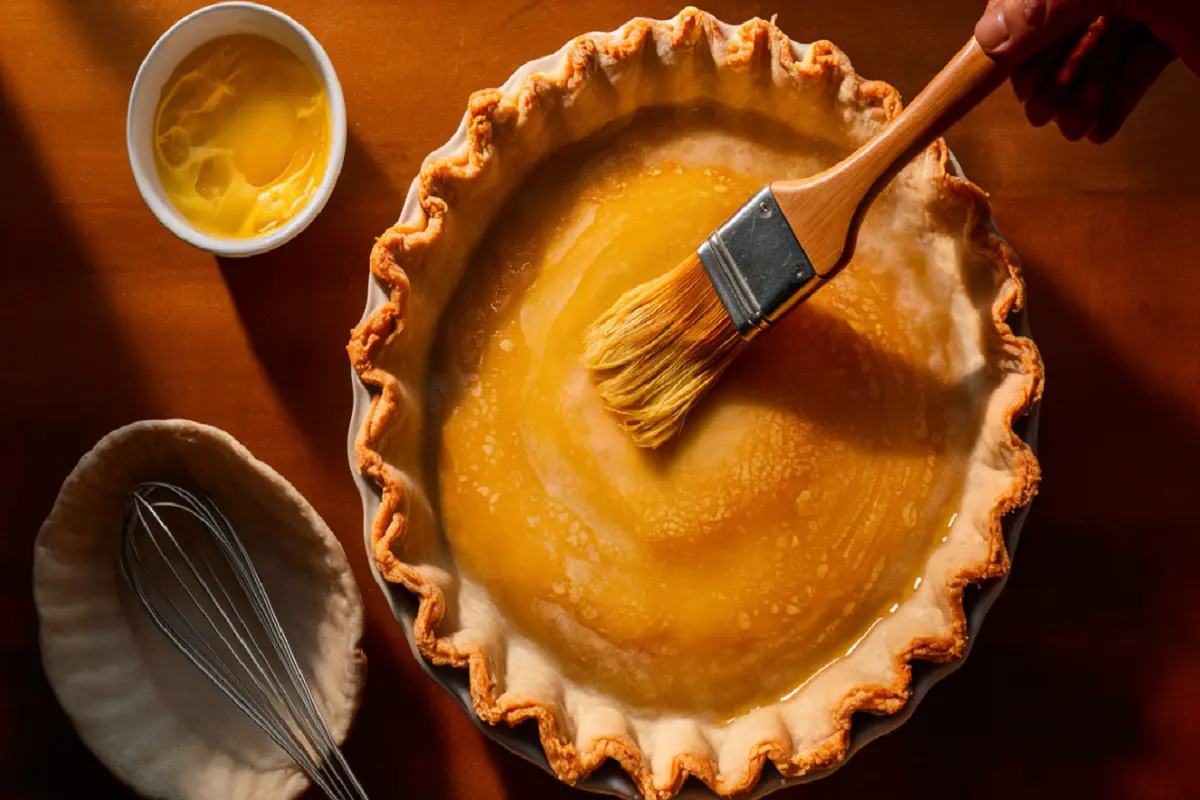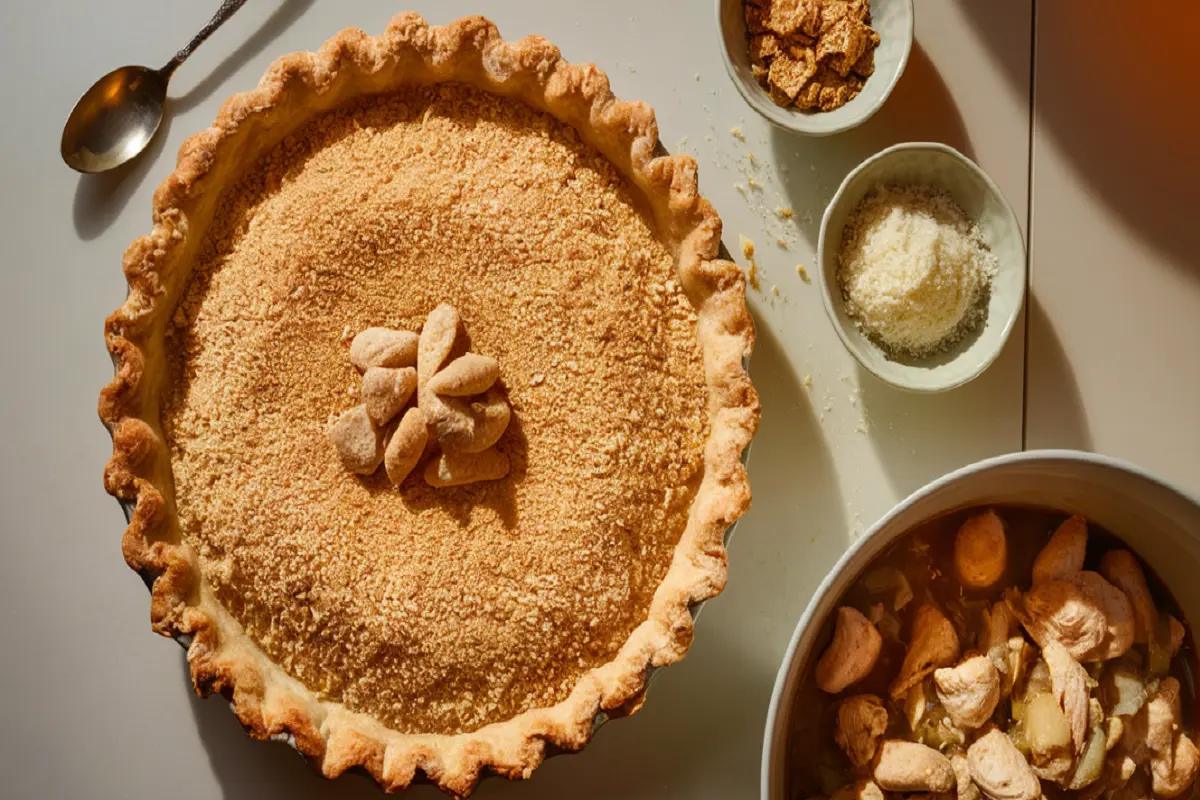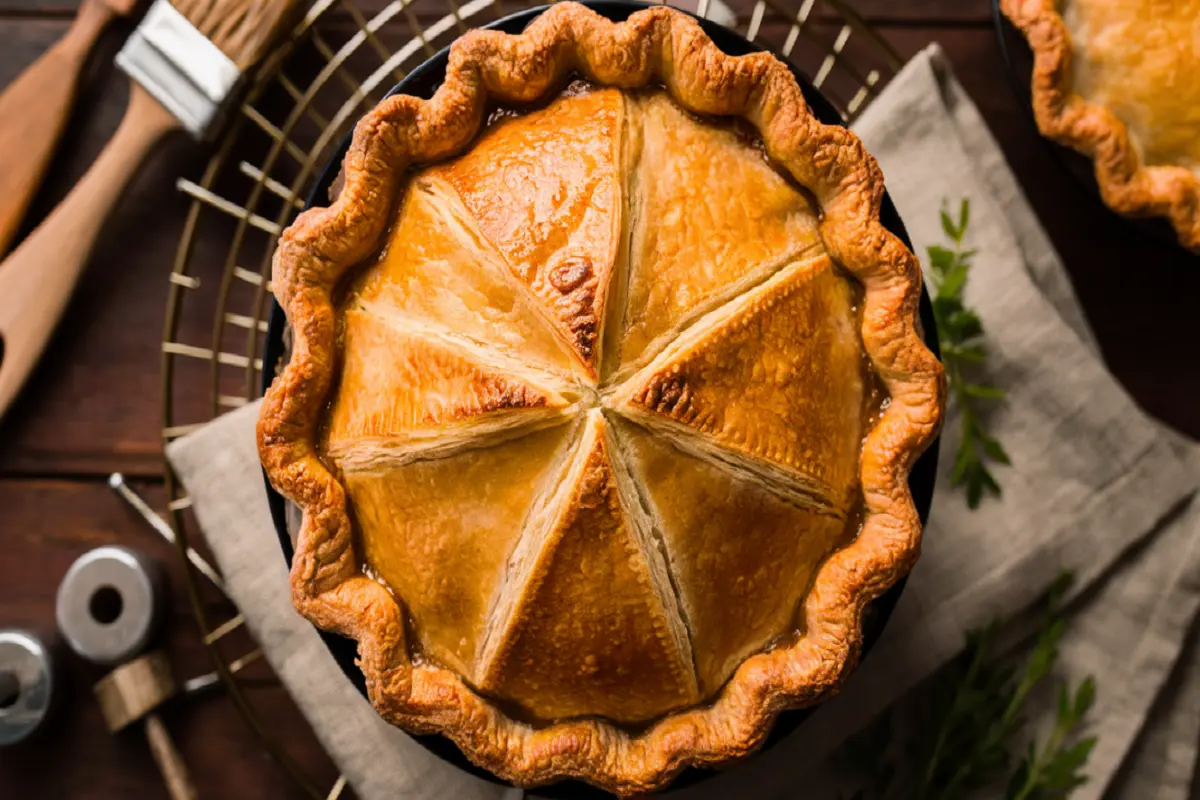Chicken pot pie is a comforting, classic dish that combines tender chicken, hearty vegetables, and a rich, savory gravy, all encased in a golden, flaky crust. While it’s a beloved dish, many home cooks face a common challenge: how to keep chicken pot pie crust from getting soggy. There’s nothing more disappointing than slicing into what should be a perfect chicken pot pie, only to find a limp, undercooked bottom crust. Mastering how to keep chicken pot pie crust from getting soggy is key to creating a perfect pot pie that’s both delicious and satisfying
In this guide, we’ll explore various techniques and tips to ensure your chicken pot pie comes out with a perfectly crisp bottom crust every time. Whether you’re a seasoned cook or new to making pot pies, these strategies will help you achieve that sought-after, golden crust.
Understanding the Problem: How to Keep Chicken Pot Pie Crust from Getting Soggy
Before diving into the solutions, it’s important to understand why the bottom crust of a chicken pot pie often ends up soggy. The main culprit is moisture. As the pie bakes, the filling releases steam and liquid, which can seep into the bottom crust, preventing it from cooking properly and achieving a crisp texture.
Several factors contribute to this issue:
- Liquid-Rich Filling: Chicken pot pie fillings are typically made with a creamy sauce, which can release excess moisture during baking.
- Steam: As the filling heats up, it releases steam, which can condense on the crust, causing it to become soggy.
- Underbaking: If the pie isn’t baked long enough or at a high enough temperature, the bottom crust won’t have a chance to crisp up.
- Incorrect Crust Placement: Placing a cold filling on a raw crust can lead to a soggy bottom, as the crust doesn’t have a chance to start baking before it’s exposed to moisture.
Understanding these factors allows us to take steps to counteract them and achieve that perfect, flaky bottom crust.
Tips and Techniques on How to Keep Chicken Pot Pie Crust from Getting Soggy
Now that we’ve identified the causes of a soggy bottom crust, let’s explore some effective strategies to prevent it.
1. Pre-Bake (Blind Bake) the Bottom Crust
One of the most effective ways to prevent a soggy bottom crust is to pre-bake, or “blind bake,” the crust before adding the filling. Blind baking is a proven method on how to keep chicken pot pie crust from getting soggy by partially cooking the crust before adding the filling. This method gives the crust a head start before it comes into contact with the filling.
How to Blind Bake the Bottom Crust:
- Roll Out the Dough: Start by rolling out your pie dough and placing it in the pie dish. Trim the edges as needed.
- Dock the Crust: Use a fork to prick holes all over the bottom of the crust. This prevents air bubbles from forming during baking.
- Use Pie Weights: Place a sheet of parchment paper or aluminum foil over the crust and fill it with pie weights, dried beans, or uncooked rice. This helps the crust hold its shape while baking.
- Bake the Crust: Bake the crust in a preheated oven at 375°F (190°C) for about 15-20 minutes, or until it’s lightly golden. Remove the pie weights and parchment paper, then bake for an additional 5-10 minutes to ensure the bottom is fully cooked.
- Cool Before Filling: Allow the crust to cool slightly before adding your filling. This step ensures that the crust maintains its integrity when the filling is added.
Blind baking creates a barrier between the crust and the filling, helping to keep it crisp and flaky.
2. Brush the Crust with Egg Wash

Another technique to prevent a soggy bottom crust is to brush the crust with an egg wash before blind baking. The egg wash acts as a moisture barrier, sealing the crust and preventing the filling’s liquid from seeping in.
How to Apply an Egg Wash:
- Prepare the Egg Wash: Beat one egg with a tablespoon of water or milk. For added flavor, you can also mix in a pinch of salt.
- Brush the Crust: After rolling out the dough and placing it in the pie dish, lightly brush the entire bottom crust with the egg wash.
- Bake the Crust: Proceed with blind baking the crust as described above. The egg wash will create a thin, protective layer that helps keep the crust crisp.
Egg wash not only helps with crispiness but also adds a beautiful golden color to the crust.
3. How to Keep Chicken Pot Pie Crust from Getting Soggy: Use a Thickened Filling
Another common cause of a soggy bottom crust is a filling that’s too liquid. Another crucial tip on how to keep chicken pot pie crust from getting soggy is ensuring your filling is properly thickened before it’s added to the crust .
Tips for a Thickened Filling:
- Use a Roux: Start your filling by making a roux (a mixture of fat and flour) to thicken the sauce. This helps absorb excess moisture and creates a rich, velvety filling.
- Add Cornstarch or Flour: If your filling is still too thin, you can thicken it with a slurry made of cornstarch or flour mixed with a little water or broth. Add this mixture to the filling while it’s simmering, and stir until it thickens.
- Reduce Liquid: Be mindful of how much broth or cream you add to the filling. Reducing the liquid will help prevent it from making the crust soggy.
A thickened filling is less likely to release excess moisture during baking, helping to keep the crust crisp.
4. How to Keep Chicken Pot Pie Crust from Getting Soggy: Add a Layer of Breadcrumbs or Crushed Crackers

Adding a dry layer between the filling and the crust can help absorb excess moisture and prevent sogginess. Breadcrumbs, crushed crackers, or even a thin layer of grated cheese can work as a barrier.
How to Add a Dry Layer:
- Sprinkle on the Crust: After blind baking the crust and before adding the filling, sprinkle a thin layer of breadcrumbs, crushed crackers, or grated cheese over the bottom crust.
- Add the Filling: Carefully spoon the filling on top of the dry layer, ensuring that it stays evenly distributed.
This technique not only helps absorb moisture but also adds an extra layer of flavor to your chicken pot pie.
5. Bake on a Lower Oven Rack
Baking your chicken pot pie on a lower oven rack can help the bottom crust cook more thoroughly. The closer proximity to the oven’s heat source encourages the bottom crust to crisp up, while the top crust browns nicely.
How to Use This Technique:
- Position the Rack: Place your oven rack in the lower third of the oven.
- Preheat the Oven: Ensure your oven is fully preheated before placing the pie inside.
- Monitor Baking Time: Since the bottom crust will be exposed to more direct heat, you may need to adjust the baking time slightly to prevent over-browning. Keep an eye on the pie as it bakes.
This method ensures that the bottom crust receives adequate heat, resulting in a crisp, golden finish.
6. Avoid Overfilling the Pie
Overfilling your chicken pot pie can lead to excess moisture, which increases the risk of a soggy bottom crust. When the pie is overfilled, the filling is more likely to bubble over the sides, seeping into the crust and making it soggy.
Tips for Proper Filling:
- Leave Space: Make sure to leave a small gap between the filling and the top of the pie crust. This allows steam to escape and prevents the filling from bubbling over.
- Avoid Too Much Liquid: Be cautious not to add too much sauce or broth to the filling. A thick, hearty filling is less likely to cause sogginess.
By controlling the amount of filling, you reduce the likelihood of the bottom crust becoming soggy.
7. Use a Vented Top Crust
A well-vented top crust allows steam to escape during baking, reducing the amount of moisture trapped inside the pie. Creating vents in the top crust is another effective technique on how to keep chicken pot pie crust from getting soggy, as it allows steam to escape during baking. This, in turn, helps keep the bottom crust from getting soggy.
How to Create a Vented Top Crust:
- Cut Slits: Before placing the top crust on the pie, cut several small slits or shapes into the dough. These vents will allow steam to escape during baking.
- Decorative Vents: Get creative with your venting! Use small cookie cutters to make decorative shapes, or simply cut slits with a knife.
- Check for Steam: As the pie bakes, make sure you see steam escaping from the vents. This is a good sign that moisture is being released.
A vented top crust not only adds visual appeal but also plays a crucial role in preventing a soggy bottom crust.
8. Use a Pie Shield
Sometimes, in the quest for a crispy bottom crust, the top crust can become too brown before the pie is fully cooked. To prevent this, use a pie shield or cover the edges of the crust with aluminum foil during the first part of baking.
How to Use a Pie Shield:
- Cover the Edges: Place a pie shield or strips of aluminum foil over the edges of the crust before placing the pie in the oven. This protects the delicate edges from over-browning.
- Remove Midway: About halfway through baking, remove the pie shield or foil to allow the edges to brown evenly.
This technique helps ensure that both the top and bottom crusts are perfectly baked.
9. Let the Pie Rest Before Serving
It can be tempting to slice into your chicken pot pie as soon as it comes out of the oven, but letting it rest for a few minutes can make a big difference in the final result. Allowing the pie to rest gives the filling time to settle and thicken, which prevents excess moisture from seeping into the bottom crust. This rest period also makes the pie easier to slice and serve.
10. Use the Right Baking Dish
The type of baking dish you use can also affect the crispness of the bottom crust. Certain materials conduct heat better than others, which can help achieve a more evenly cooked and crispy crust.
Best Types of Baking Dishes for Chicken Pot Pie:
- Glass Pie Dishes: Glass is an excellent conductor of heat and allows you to see the bottom crust as it bakes. This transparency can help you monitor the crust’s color and crispness.
- Metal Pie Pans: Metal pans, especially those made of aluminum, heat up quickly and distribute heat evenly. They’re a good choice for achieving a crispy bottom crust.
- Ceramic Pie Dishes: While ceramic dishes are beautiful and hold heat well, they may not conduct heat as efficiently as glass or metal. If using ceramic, consider preheating the dish before adding the crust and filling.
Choosing the right baking dish can make a significant difference in how well your bottom crust cooks.
11. Consider a Double Crust or Lattice Top
Using a double crust or a lattice top can help reduce moisture content in the filling by allowing more steam to escape. Both techniques create a balanced structure that distributes heat evenly across the pie, helping to keep the bottom crust crisp.
How to Create a Double Crust:
- Roll Out the Dough: Roll out the bottom crust and place it in the pie dish, allowing it to overlap the edges slightly.
- Add the Filling: Spoon the filling into the prepared crust, ensuring it’s not too soupy.
- Top with Second Crust: Roll out the second piece of dough and place it over the filling. Trim the excess dough and crimp the edges to seal.
- Vent the Top: Remember to cut vents in the top crust to allow steam to escape.
How to Create a Lattice Top:
- Cut Dough Strips: Roll out the top dough and cut it into even strips using a knife or pastry cutter.
- Weave the Lattice: Lay half of the strips horizontally across the pie. Then, weave the remaining strips vertically, lifting alternate horizontal strips as you go to create a lattice pattern.
- Crimp the Edges: Trim any excess dough and crimp the edges to seal.
Both double crust and lattice top techniques not only enhance the visual appeal of your pie but also contribute to a better-textured bottom crust.
12. Experiment with Different Fat Sources in Your Crust
The type of fat used in your pie crust can influence how well it bakes and how crisp it becomes. Traditional options like butter, shortening, or lard each have their own qualities that can affect the final result.
Comparing Fats for Pie Crust:
Butter: Butter is a popular choice for pie crusts because it adds rich flavor and helps create a flaky texture. However, butter has a lower melting point, which can sometimes lead to a softer crust if not handled properly.
Shortening: Shortening is higher in fat and has a higher melting point than butter, which can help create a more tender and slightly crispier crust. However, it lacks the rich flavor that butter provides.
Lard: Lard produces an exceptionally flaky and crispy crust due to its high fat content and structure. It’s a traditional choice, especially in savory pies, but can be harder to find.
Oil: Some pie crust recipes use oil, which results in a tender crust that’s easy to handle. However, oil-based crusts may not be as flaky or crispy as those made with solid fats.
Experimenting with different fats or a combination of them (e.g., half butter, half shortening) can help you find the perfect balance between flavor and crispiness for your chicken pot pie crust.
13. Adjust Baking Time and Temperature
Achieving a crispy bottom crust may require some adjustments to your baking time and temperature. A higher initial baking temperature can help set the bottom crust before the filling releases too much moisture.
Baking Tips:
- Start with a High Temperature: Begin baking your pie at 425°F (220°C) for the first 15-20 minutes. This high heat helps the bottom crust set quickly.
- Lower the Temperature: After the initial baking period, reduce the oven temperature to 375°F (190°C) and continue baking until the filling is bubbly and the top crust is golden brown. This method ensures that both the top and bottom crusts are fully cooked without burning.
- Bake Longer if Needed: If you notice that the bottom crust isn’t as crisp as you’d like, you can extend the baking time by covering the top crust with foil to prevent it from over-browning.
Adjusting the baking time and temperature can help you achieve the perfect balance between a well-cooked filling and a crispy bottom crust.
14. Consider Pre-Cooking the Filling
Another technique to reduce moisture and prevent a soggy crust is to pre-cook the filling before assembling the pie. This method allows some of the excess moisture to evaporate before it has a chance to soak into the bottom crust.
How to Pre-Cook the Filling:
- Sauté the Ingredients: Begin by sautéing the vegetables and cooking the chicken in a skillet. This step helps release some of the moisture from the ingredients.
- Simmer the Sauce: Add the broth, cream, and seasonings to the skillet, and let the filling simmer until it thickens. This process reduces the liquid content.
- Cool Slightly: Allow the filling to cool slightly before adding it to the pie crust. A cooler filling will release less steam during baking, which helps keep the crust crisp.
Pre-cooking the filling can be especially helpful if you’re using particularly juicy vegetables or adding extra liquid to the recipe.
15. Use a Baking Stone or Steel
If you’re serious about achieving a perfectly crispy bottom crust, consider baking your chicken pot pie on a preheated baking stone or steel. These tools retain heat and distribute it evenly, which can help the bottom crust cook more thoroughly.
How to Use a Baking Stone or Steel:
- Preheat the Stone/Steel: Place the baking stone or steel on the lowest rack of your oven and preheat it along with the oven for at least 30 minutes.
- Bake Directly on the Stone/Steel: Place your pie dish directly on the preheated stone or steel. The intense heat will help the bottom crust cook quickly and evenly.
- Monitor Baking Time: Since the baking stone or steel will increase the heat to the bottom of the pie, you may need to adjust the baking time slightly to prevent over-browning.
Using a baking stone or steel is a professional technique that can elevate your chicken pot pie to the next level by ensuring a crispy, evenly cooked bottom crust.
16. Let the Pie Cool on a Wire Rack
After baking, it’s important to cool your pie properly to maintain the crispness of the bottom crust. Cooling the pie on a wire rack allows air to circulate underneath, preventing the crust from becoming soggy due to trapped steam.
How to Cool the Pie:
- Remove from Oven: Once the pie is fully baked and the crust is golden brown, carefully remove it from the oven.
- Place on a Wire Rack: Set the pie on a wire cooling rack, which elevates it and allows air to circulate around the entire pie, including the bottom crust.
- Cool Completely: Allow the pie to cool for at least 15-20 minutes before slicing. This cooling period lets the filling set, making it easier to slice without compromising the crust’s crispness.
Proper cooling is the final step in ensuring your chicken pot pie has a perfectly crisp bottom crust.
17. Avoid Using a Wet or Raw Filling
One common mistake that leads to a soggy bottom crust is using a filling that is too wet or raw. Ensure that your filling ingredients, especially vegetables, are cooked or at least sautéed before adding them to the pie.
How to Prepare the Filling:
- Cook Vegetables Thoroughly: Vegetables like onions, carrots, and celery release moisture as they cook. Sauté them in a pan until they are softened and most of their liquid has evaporated.
- Use Thickened Sauces: As mentioned earlier, ensure that the sauce in your filling is thickened to the right consistency before adding it to the pie. A thick sauce will not seep into the crust as much as a thin, watery one.
By avoiding wet or raw fillings, you significantly reduce the risk of ending up with a soggy bottom crust.
18. Store and Reheat Properly
Even if you’ve done everything right during the initial baking, improper storage and reheating can cause the bottom crust to become soggy. Here’s how to store and reheat your chicken pot pie to maintain its crispness:
Storing Tips:
- Cool Completely: Allow the pie to cool completely before storing it. This prevents condensation from forming, which can make the crust soggy.
- Cover Loosely: If storing at room temperature, cover the pie loosely with aluminum foil. For longer storage, refrigerate the pie in an airtight container.
Reheating Tips:
- Use the Oven: Reheat the pie in a preheated oven at 350°F (175°C) for about 20-30 minutes, or until heated through. This method helps the crust regain its crispness.
- Avoid the Microwave: Reheating in the microwave can make the crust soggy due to uneven heating and trapped steam.
Proper storage and reheating techniques ensure that your chicken pot pie remains deliciously crispy, even as leftovers.
19. Experiment and Customize
Every kitchen and recipe is different, so don’t be afraid to experiment with these techniques to find what works best for you. Adjusting the recipe, baking method, or even trying different types of crusts can help you achieve the perfect chicken pot pie with a crisp bottom crust every time.
Conclusion
A soggy bottom crust can be a disappointing outcome for any chicken pot pie, but with the right techniques and attention to detail, you can achieve a perfectly crisp and golden crust. Whether it’s blind baking, using a thickened filling, adjusting your baking time and temperature, or any of the other strategies discussed, there are plenty of ways to keep your bottom crust from getting soggy.
By understanding the causes of sogginess and applying these practical tips, you can elevate your chicken pot pie to new heights, delighting family and friends with every bite. Happy baking!

